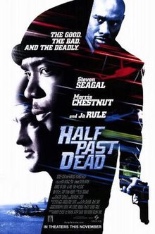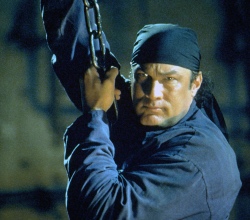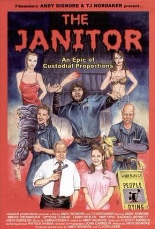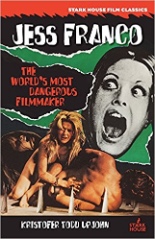
 Prophetically titled, Half Past Dead was Steven Seagal’s last theatrical hurrah as an action hero. Either as a sign of desperation or as a self-deluded desire of demonstrating range, the former tuffie agreed to wear a ’do rag and play a Russian, yet eschewed any attempt at an accent. Leave that shit to Meryl, right?
Prophetically titled, Half Past Dead was Steven Seagal’s last theatrical hurrah as an action hero. Either as a sign of desperation or as a self-deluded desire of demonstrating range, the former tuffie agreed to wear a ’do rag and play a Russian, yet eschewed any attempt at an accent. Leave that shit to Meryl, right?
Seagal’s Sasha Petrosevitch works undercover for the FBI. As the film opens, Sasha is introduced to a crime syndicate boss named Eckvall (but it sounded like “Eggfart”), helps take down an arrogant criminal (arrogant rapper Ja Rule, 2001’s The Fast and the Furious), almost dies for it (hence the title) and dons prison garb at New Alcatraz.
While Sasha is in the clinker, a bald bad guy (Bruce Weitz, Deep Impact) is scheduled to be executed for stealing $200 million in government gold bars, and the Supreme Court justice (Linda Thorson, Curtains) who helped put him away is there to witness. So naturally, a gang of would-be thieves drops in via helicopter and takes the justice hostage until the death-row inmate reveals where he’s hidden that loot.
 The treasure hunters’ leaders are played by Morris Chestnut (2015’s Heist) and Nia Peeples (Werewolf: The Beast Among Us), who looks like she’s wearing the prototype for Sears’ Underworld collection and moves as if she were Michael Myers from Halloween.
The treasure hunters’ leaders are played by Morris Chestnut (2015’s Heist) and Nia Peeples (Werewolf: The Beast Among Us), who looks like she’s wearing the prototype for Sears’ Underworld collection and moves as if she were Michael Myers from Halloween.
This all results in an action free-for-all. Martial arts! Pornographic gunplay! Acrobatic swinging from chains! Guards thrown through glass! Story be damned! Written and directed by former actor Don Michael Paul (Rolling Vengeance), Half Past Dead seems interested only in being so slick that one could cook pancakes on it and not have them stick. Such an approach is admittedly entertaining, even when it’s absolutely absurd. —Rod Lott


 It is hard to believe there was a time in this country when Americans shelled out thousands of dollars not just to drive vans as a primary mode of transportation, but to emblazon them with airbrushed fantasies of mermaids and Mickey Mouse and more, all of which look to have been dictated to a slumming Frank Frazetta by a toddler who forgot to take his Ritalin that morning. And yet here, to serve as historical record (and little else) is proof:
It is hard to believe there was a time in this country when Americans shelled out thousands of dollars not just to drive vans as a primary mode of transportation, but to emblazon them with airbrushed fantasies of mermaids and Mickey Mouse and more, all of which look to have been dictated to a slumming Frank Frazetta by a toddler who forgot to take his Ritalin that morning. And yet here, to serve as historical record (and little else) is proof: 


 Reclusive widow Sarah Winchester (Helen Mirren,
Reclusive widow Sarah Winchester (Helen Mirren, 




